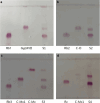Transcriptome Profiling, Cloning, and Characterization of AnGlu04478, a Ginsenoside Hydrolyzing β-Glucosidase from Aspergillus niger NG1306
- PMID: 39718650
- PMCID: PMC11668888
- DOI: 10.1007/s00284-024-04012-0
Transcriptome Profiling, Cloning, and Characterization of AnGlu04478, a Ginsenoside Hydrolyzing β-Glucosidase from Aspergillus niger NG1306
Abstract
β-Glucosidase plays a pivotal role in transforming ginsenosides into specific minor ginsenosides. In this study, total ginsenosides from Panax notoginseng leaves were used as substrates to stimulate the growth of Aspergillus niger NG1306. Transcriptome analysis identified a β-glucosidase gene, Anglu04478 (1455 bp, 484 amino acids, 54.5 kDa, pI = 5.1), as a participant in the ginsenosides biotransformation process. This gene was cloned and expressed in Escherichia coli BL21 Transetta (DE3). The AnGlu04478 protein was purified using a Ni2+ column, and its enzymatic properties were characterized. Purified AnGlu04478 exhibited a specific activity of 32.97 U/mg when assayed against pNPG. Under optimal conditions (pH 4.5, temperature 40 °C), the kinetic parameters, Km and Vmax, for pNPG were 1.55 mmol/L and 0.014 mmol/min, respectively. Cu2+ displayed an inhibitory effect on AnGlu04478, whereas Ca2+, Co2+, and Ni2+ ions had minimal impact. The enzyme showed tolerance to ethanol and was largely unaffected by glucose feedback inhibition. Testing with ginsenosides as substrates revealed selective hydrolysis at the C3 position of ginsenosides Rb1, Rb2, Rb3, and Rc, with the metabolic pathway delineated as Rb1 → GypXVII, Rb2 → C-O, Rb3 → C-Mx1 → C-Mx, and Rc → C-Mc1. The conversion rates of ginsenosides Rb1, Rb2, Rb3, and Rc varied from 2.58 to 20.63%. With 0.5 U purified enzyme and 0.5 mg total ginsenosides, incubated at 40 °C for 12 h, the conversion rates were 42.6% for GypXVII, 10.4% for C-O, 6.27% for C-Mx1, 26.96% for C-Mx, and 90% for Rc. These results suggest that AnGlu04478 displays substrate promiscuity as a β-glucosidase, thus broadening the potential for ginsenoside biotransformation.
© 2024. The Author(s).
Conflict of interest statement
Declarations. Conflict of interest: The authors have no financial conflicts of interest to declare.
Figures





Similar articles
-
Characterization of recombinant β-glucosidase from Arthrobacter chlorophenolicus and biotransformation of ginsenosides Rb1, Rb 2, Rc, and Rd.J Microbiol. 2014 May;52(5):399-406. doi: 10.1007/s12275-014-3601-7. Epub 2014 May 9. J Microbiol. 2014. PMID: 24810319
-
Purification and characterization of a ginsenoside Rb(1)-hydrolyzing β-glucosidase from Aspergillus niger KCCM 11239.Int J Mol Sci. 2012;13(9):12140-12152. doi: 10.3390/ijms130912140. Epub 2012 Sep 24. Int J Mol Sci. 2012. PMID: 23109906 Free PMC article.
-
Enzymatic biotransformation of ginsenoside Rb1 to 20(S)-Rg3 by recombinant β-glucosidase from Microbacterium esteraromaticum.Appl Microbiol Biotechnol. 2012 Apr;94(2):377-84. doi: 10.1007/s00253-011-3861-7. Epub 2012 Jan 17. Appl Microbiol Biotechnol. 2012. PMID: 22249721
-
Cloning and Characterization of Ginsenoside-Hydrolyzing β-Glucosidase from Lactobacillus brevis That Transforms Ginsenosides Rb1 and F2 into Ginsenoside Rd and Compound K.J Microbiol Biotechnol. 2016 Oct 28;26(10):1661-1667. doi: 10.4014/jmb.1605.05052. J Microbiol Biotechnol. 2016. PMID: 27435543
-
Comparative analysis of the expression level of recombinant ginsenoside-transforming β-glucosidase in GRAS hosts and mass production of the ginsenoside Rh2-Mix.PLoS One. 2017 Apr 19;12(4):e0176098. doi: 10.1371/journal.pone.0176098. eCollection 2017. PLoS One. 2017. PMID: 28423055 Free PMC article.
Cited by
-
Microbial Fermentation Affects the Structure-Activity Relationship of Bioactive Compounds in Ginseng and Its Applications in Fermentation Products: A Review.Foods. 2025 Jul 15;14(14):2473. doi: 10.3390/foods14142473. Foods. 2025. PMID: 40724294 Free PMC article. Review.
References
-
- Fuzzati N (2004) Analysis methods of ginsenosides. J Chromatogr B 812:119–133. 10.1016/j.jchromb.2004.07.039 - PubMed
-
- Yang WZ, Hu Y, Wu WY et al (2014) Saponins in the genus Panax L. (Araliaceae): a systematic review of their chemical diversity. Phytochemistry 106:7–24. 10.1016/j.phytochem.2014.07.012 - PubMed
-
- Attele AS, Wu JA, Yuan CS (1999) Ginseng pharmacology: multiple constituents and multiple actions. Biochem Pharmacol 58:1685–1693. 10.1016/s0006-2952(99)00212-9 - PubMed
MeSH terms
Substances
Grants and funding
LinkOut - more resources
Full Text Sources
Research Materials
Miscellaneous

